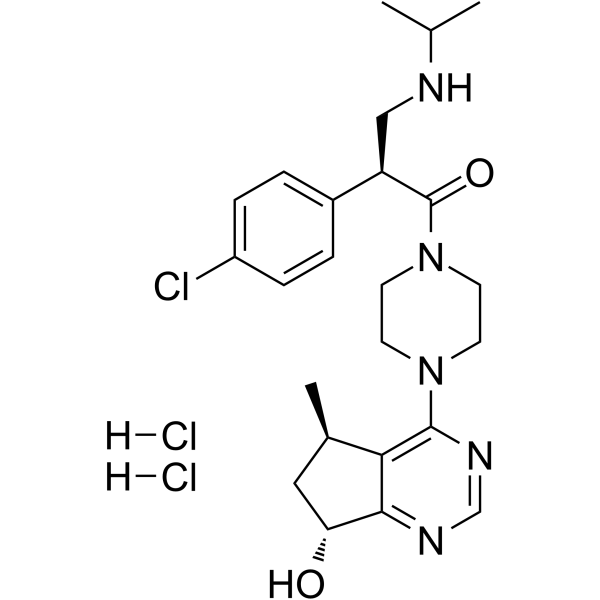
Ipatasertib dihydrochloride
CAS No. 1396257-94-5
Ipatasertib dihydrochloride( GDC-0068 dihydrochloride | RG-7440 dihydrochloride )
Catalog No. M26694 CAS No. 1396257-94-5
Ipatasertib dihydrochloride is a highly selective and ATP-competitive inhibitor of pan-Akt (IC50s: 5, 18 and 8 nM for Akt1, Akt2 and Akt3, respectively).
Purity : >98% (HPLC)
 COA
COA
 Datasheet
Datasheet
 HNMR
HNMR
 HPLC
HPLC
 MSDS
MSDS
 Handing Instructions
Handing Instructions
| Size | Price / USD | Stock | Quantity |
| 2MG | 35 | Get Quote |


|
| 5MG | 50 | Get Quote |


|
| 10MG | 71 | Get Quote |


|
| 100MG | Get Quote | Get Quote |


|
| 200MG | Get Quote | Get Quote |


|
| 500MG | Get Quote | Get Quote |


|
| 1G | Get Quote | Get Quote |


|
Biological Information
-
Product NameIpatasertib dihydrochloride
-
NoteResearch use only, not for human use.
-
Brief DescriptionIpatasertib dihydrochloride is a highly selective and ATP-competitive inhibitor of pan-Akt (IC50s: 5, 18 and 8 nM for Akt1, Akt2 and Akt3, respectively).
-
DescriptionIpatasertib dihydrochloride is a highly selective and ATP-competitive inhibitor of pan-Akt (IC50s: 5, 18 and 8 nM for Akt1, Akt2 and Akt3, respectively).(In Vitro):Ipatasertib displays more than 600 and more than 100-fold selectivity for Akt1 in IC50 against the closely related kinases PKA and p70S6K, respectively. Ipatasertib inhibits only 3 other kinases by more than 70% at 1 μM concentration (PRKG1α, PRKG1β, and p70S6K) when tested at 1 μM in a panel of 230 protein kinases, which includes 36 human AGC family members. IC50s measured for these 3 kinases are 98, 69, and 860 nM, respectively. The relationship between pharmacokinetics (PK) and pharmacodynamics (PD) of Ipatasertib is investigated in 3 xenograft models that showed a dose-dependent response to drug treatment: MCF7-neo/HER2, TOV-21G.x1, and LNCaP. The mean cell viability IC50 of Ipatasertib in these 3 cell lines is 2.56, 0.44, and 0.11 μM, respectively. Ipatasertib shows a more than 100-fold selectivity for Akt1 over the next most potently inhibited non-Akt kinase, p70S6K, in the screening kinase panel with the exception of PKG1 (relative to which Ipatasertib is >10-fold more selective for Akt1). (In Vivo):Ipatasertib is typically efficacious in xenograft models in which Akt is activated because of genetic alterations including PTEN loss, PIK3CA mutations/amplifications, or HER2 overexpression. The combination of Ipatasertib with RP-56976 or NSC 241240 is tolerated with less than 5% body weight loss when compared with treatment with each chemotherapeutic agent alone. The daily dosing of Ipatasertib in combination with RP-56976 induces tumor regression and stasis in the PC-3 and MCF7-neo/HER2 xenograft models, at doses where every single agent is ineffective or only causes modest tumor growth delay, when tested in vivo. Similarly, enhanced TGI is observed in the OVCAR3 ovarian cancer xenograft model when Ipatasertib is combined with NSC 241240.
-
In Vitro——
-
In Vivo——
-
SynonymsGDC-0068 dihydrochloride | RG-7440 dihydrochloride
-
PathwayCytoskeleton/Cell Adhesion Molecules
-
TargetAkt
-
RecptorGPR109B
-
Research Area——
-
Indication——
Chemical Information
-
CAS Number1396257-94-5
-
Formula Weight530.92
-
Molecular FormulaC24H34Cl3N5O2
-
Purity>98% (HPLC)
-
SolubilityIn Vitro:?DMSO : 100 mg/mL (188.35 mM)
-
SMILESCl.Cl.CC(C)NC[C@@H](C(=O)N1CCN(CC1)c1ncnc2[C@H](O)C[C@@H](C)c12)c1ccc(Cl)cc1
-
Chemical Name——
Shipping & Storage Information
-
Storage(-20℃)
-
ShippingWith Ice Pack
-
Stability≥ 2 years
Reference
1.Radivojevic J, et al. Polyhydroxyalkanoate-based 3-hydroxyoctanoic acid and its derivatives as a platform of bioactive compounds. Appl Microbiol Biotechnol. 2016 Jan;100(1):161-72.
molnova catalog



related products
-
M2698
M2698 (MSC2363318A) is an inhibitor of p70S6K, Akt1 and Akt3 with IC50s of 1 nM. M2698 shows anti-cancer activity.
-
Honokiol
Honokiol (0, 12.5, 25 and 50 μM) inhibits the growth of GBM cells and induces apoptosis, with IC50 of appr against 30 μM DBTRG-05MG cell.
-
Chromeceptin
Chromeceptin is an inhibitor of the IGF signaling pathway, decreases the numbers of tumorsphere, and inhibits the AKT/mTOR pathway.



 Cart
Cart
 sales@molnova.com
sales@molnova.com


